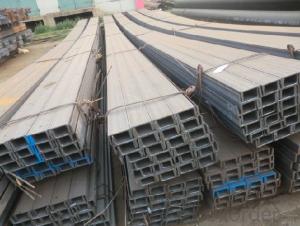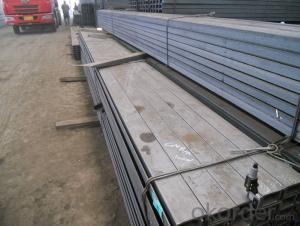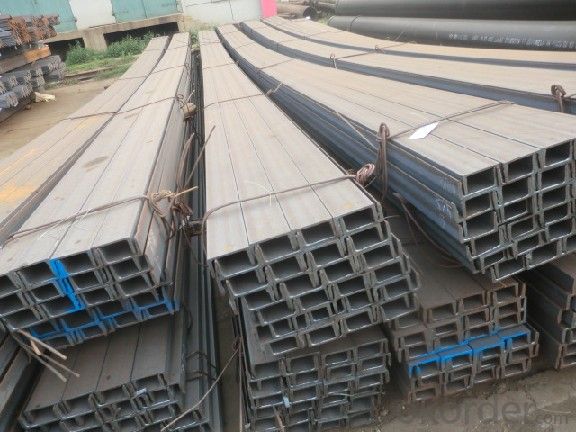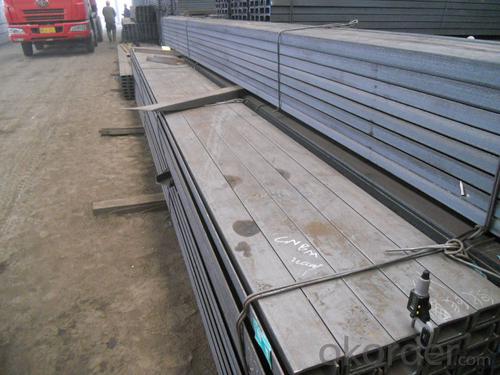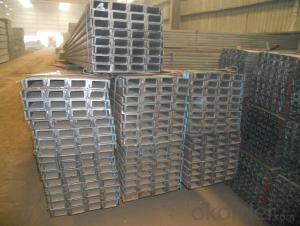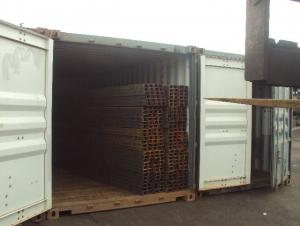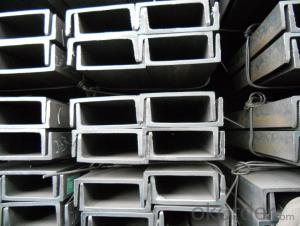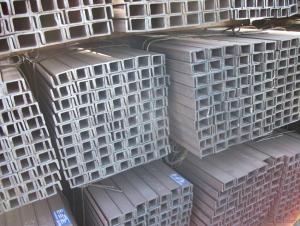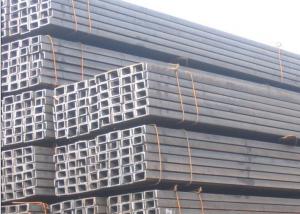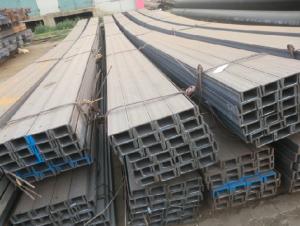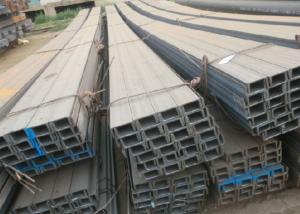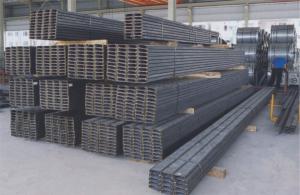Hot Rolled U-channel Carbon Steel JIS Standard
- Loading Port:
- Tianjin
- Payment Terms:
- TT or LC
- Min Order Qty:
- 25 m.t.
- Supply Capability:
- 1000 m.t./month
OKorder Service Pledge
OKorder Financial Service
You Might Also Like
Product Description:
OKorder is offering U-channel at great prices with worldwide shipping. Our supplier is a world-class manufacturer of steel, with our products utilized the world over. OKorder annually supplies products to European, North American and Asian markets. We provide quotations within 24 hours of receiving an inquiry and guarantee competitive prices.
Product Applications:
1.The JIS channel can be devided into two kinds, namely common channel steel and light channel steel. The sizes of hot rolled common channel steel range from 5# to 40#. Meanwhile, the channel steel can be divided into cold forming sectional equal channel steel, cold forming sectional unequal channel steel, cold forming inner edge channel steel and outer edge channel steel.
2.The JIS channel is usually used for arch-itechtural structure, and they could be welded in order to support or hang a vari-ety of facilities. They are also usually used in combination with I beam. The channel steel with sizes under 14# is usually applied to construction engineering, as purline, while the channel steel with sizes above 16# is more likely to be used in building vehicle chassis structure and mechanical structure. Furthermore, the channel steel in sizes above 30# are target at building bridge structure, as tension bar.
Product Advantages:
OKorder's U-channel are durable, strong, and resist corrosion.
Main Product Features:
· Premium quality
· Prompt delivery & seaworthy packing (30 days after receiving deposit)
· Corrosion resistance
· Can be recycled and reused
· Mill test certification
· Professional Service
· Competitive pricing
Product Specifications:
1. We are definitely speciallizing in manufacturing and supplying channel steel as per japanese standard, which is characterised with high mechanical strength and competitive prices.
2. The sections in details are as followings in the table-1
JIS CHANNEL | Standard h | Sectional b | Dimension s | t | Mass: Kg/m |
(mm) | (mm) | (mm) | (mm) | ||
50x25 | 50 | 25 | 3.0 | 6.00 | 2.37 |
75X40 | 75 | 40 | 3.8 | 7.00 | 5.30 |
75X40 | 75 | 40 | 4.0 | 7.00 | 5.60 |
75X40 | 75 | 40 | 4.5 | 7.00 | 5.85 |
75X40 | 75 | 40 | 5.0 | 7.00 | 6.92 |
100X50 | 100 | 50 | 3.8 | 6.00 | 7.30 |
100X50 | 100 | 50 | 4.2 | 6.00 | 8.03 |
100X50 | 100 | 50 | 4.5 | 7.50 | 8.97 |
100X50 | 100 | 50 | 5.0 | 7.50 | 9.36 |
125X65 | 125 | 65 | 5.2 | 6.80 | 11.66 |
125X65 | 125 | 65 | 5.3 | 6.80 | 12.17 |
125X65 | 125 | 65 | 5.5 | 8.00 | 12.91 |
125X65 | 125 | 65 | 6.0 | 8.00 | 13.40 |
150x75 | 150 | 75 | 5.5 | 7.30 | 14.66 |
150x75 | 150 | 75 | 5.7 | 10.00 | 16.71 |
150x75 | 150 | 75 | 6.0 | 10.00 | 17.90 |
150x75 | 150 | 75 | 6.5 | 10.00 | 18.60 |
150x75 | 150 | 75 | 6.5 | 10.00 | 24.00 |
200X80 | 200 | 80 | 7.5 | 11.00 | 24.60 |
Note of U-channel
1. According to national standard (GB) for our products, if not, supply according to national standards (GB) or agreement.
2. We can not only provide electric furnace +LF+VD and electros lag re-melting (ESR) steel forging materials, but also forging products of piece, bar, etc.
3. Our company is equipped with roll equipment and can provide our customers with roll billets or finished.
4. The materials that we purchase are all accord with International General Standard; you could check it out on the Material Quality Sheet.
5. We are the creator of the “seven-step inspect method” in China.
FAQ:
Q1: How soon can we receive the product after purchase?
A1: Within three days of placing an order, we will begin production. The specific shipping date is dependent upon international and government factors, but is typically 7 to 10 workdays.
Q2: What makes stainless steel stainless?
A2: Stainless steel must contain at least 10.5 % chromium. It is this element that reacts with the oxygen in the air to form a complex chrome-oxide surface layer that is invisible but strong enough to prevent further oxygen from "staining" (rusting) the surface. Higher levels of chromium and the addition of other alloying elements such as nickel and molybdenum enhance this surface layer and improve the corrosion resistance of the stainless material.
Q3: How soon can we receive the product after purchase?
A3: Within three days of placing an order, we will begin production. The specific shipping date is dependent
Images:
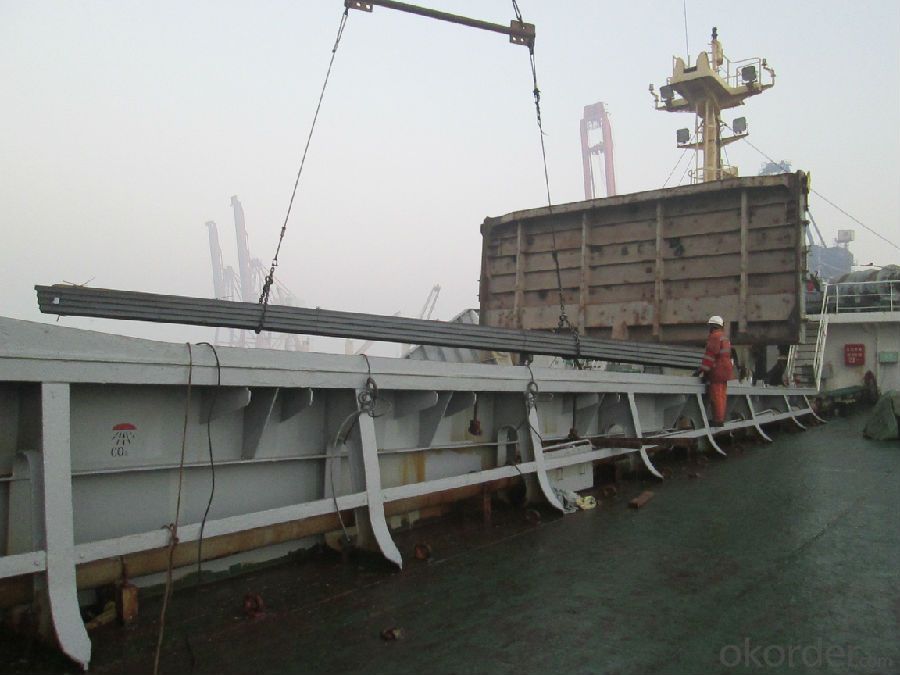

- Q: How do steel channels contribute to the overall accessibility of a structure?
- There are various ways in which steel channels contribute to the overall accessibility of a structure. Firstly, they are commonly used as support beams or columns during the construction of buildings and bridges. These channels offer structural integrity and stability, allowing for the creation of open spaces and wide doorways that enhance accessibility. Moreover, steel channels can be employed to construct ramps or walkways that facilitate movement for individuals with mobility impairments. By utilizing steel channels as the framework for these accessibility features, architects and engineers can ensure they have sufficient strength to support the weight of wheelchairs or other assistive devices. Furthermore, in multi-story buildings, steel channels are frequently utilized in the construction of elevators and escalators, which are essential elements for improving accessibility. These channels form the framework for the track systems that allow elevators and escalators to operate smoothly and safely, enabling people with mobility challenges to easily navigate between different levels. In addition, steel channels can be used to create handrails or guardrails along staircases, ramps, or walkways. These safety features provide support and stability for individuals with disabilities or those who struggle with balance, ensuring secure movement within the structure. Overall, steel channels play a critical role in enhancing the accessibility of a structure by providing structural support, facilitating the construction of ramps and walkways, enabling the installation of elevators and escalators, and creating safety features such as handrails and guardrails. These contributions make structures more inclusive and accommodating for individuals with disabilities or limited mobility.
- Q: How do steel channels contribute to natural ventilation?
- Natural ventilation can be enhanced by steel channels in various ways. Firstly, these channels can be utilized to construct air vents or openings within buildings. These openings allow fresh air to enter the building, promoting air circulation and eliminating stagnant air, thus improving the quality of indoor air. To optimize airflow and establish a natural air current, strategic placement of the channels is imperative. Furthermore, steel channels can be employed to fashion louvers or slats in windows or facades. These louvers enable adjustable ventilation, enabling individuals to regulate the amount of air entering the building based on their preferences. By manipulating the position of the louvers, the airflow can be directed towards specific areas or rooms, providing targeted ventilation in areas where it is most needed. Moreover, steel channels can be utilized to construct chimneys or exhaust vents. These structures aid in expelling hot air, smoke, and other pollutants from the building, creating a healthier and more comfortable indoor environment. By generating a vertical airflow, the channels facilitate the dissipation of accumulated heat and enhance air circulation, which is particularly advantageous in spaces with high humidity or where unpleasant smells and contaminants may be present. In summary, steel channels play a vital role in facilitating natural ventilation by providing openings, louvers, and exhaust vents that promote the movement of air. By harnessing natural forces like wind and thermal buoyancy, these channels contribute to the development of a sustainable and energy-efficient ventilation system that enhances the comfort and well-being of building occupants.
- Q: What are the different surface protection techniques for steel channels?
- To prevent corrosion and enhance the durability of steel channels, there are several surface protection techniques available. These techniques are as follows: 1. Galvanization: Applying a protective zinc coating to the steel channel serves as a sacrificial anode, creating a barrier against corrosion. Galvanized steel channels are highly resistant to rust and can withstand harsh environmental conditions. 2. Powder coating: The application of a dry powder to the steel channel, followed by heating, creates a durable and protective finish. This technique provides excellent resistance against corrosion, chemicals, and UV rays, while also offering a wide range of color options. 3. Epoxy coating: Epoxy coatings are suitable for steel channels exposed to chemicals or harsh environments. By applying a layer of epoxy resin, a protective barrier forms against corrosion, abrasion, and impact. 4. Paint coatings: Painting the steel channel with a layer of paint is a cost-effective surface protection method. The paint acts as a barrier, preventing moisture and oxygen from reaching the metal surface, thus reducing the risk of corrosion. Depending on specific requirements, different types of paints, such as acrylic, enamel, or epoxy, can be used. 5. Stainless steel cladding: This method involves covering the steel channel with a layer of stainless steel. Stainless steel is highly resistant to rust and oxidation, providing excellent corrosion resistance. Additionally, it offers a visually appealing and durable finish. 6. Hot-dip coating: Immersing the steel channel in a bath of molten zinc creates a thick and uniform zinc coating. This technique provides exceptional protection against corrosion and is commonly used in outdoor applications where the steel channel may be exposed to moisture, chemicals, or extreme temperatures. Each of these surface protection techniques has its own advantages and suitability for specific applications. The choice of technique depends on factors such as the environment, desired aesthetics, durability requirements, and budget considerations.
- Q: How do steel channels perform in high-traffic areas?
- Steel channels perform well in high-traffic areas due to their durability and strength. They can withstand heavy loads and provide excellent support, making them ideal for use in areas with high foot or vehicle traffic. Additionally, steel channels have a long lifespan and require minimal maintenance, making them a reliable choice for high-traffic areas.
- Q: What are the different tolerances for steel channels?
- The steel channels' tolerances can differ depending on the specific standards and specifications set by the manufacturing industry or project requirements. Typically, the dimensions such as width, depth, and length are used to specify the tolerances for steel channels. For instance, the acceptable measurements for width and depth of steel channels are usually defined within a range. This range accounts for minor variations in channel dimensions, ensuring that it still meets the required specifications while allowing for manufacturing differences. To ensure the desired length requirements are met, the tolerance for steel channels' length can also be specified. This may include tolerances for both the overall length of the channel and any specific lengths needed for certain sections or cuts. In addition to dimensional tolerances, surface finish and straightness may also be specified. Surface finish tolerances determine the acceptable level of smoothness or roughness on the surface of the steel channel. Straightness tolerances define how much deviation from a straight line is acceptable for the channel. It is important to note that the tolerances for steel channels can vary depending on factors such as the industry, application, and the standards being followed. Therefore, it is always necessary to refer to the relevant standards or project specifications to determine the precise tolerances for a specific steel channel.
- Q: What are the considerations for steel channel connections to steel beams?
- There are several important factors that need to be taken into account when considering connections between steel channels and steel beams. The first and most important factor is to ensure that the connection is structurally sound and capable of withstanding the intended loads and forces. This requires a thorough analysis of the design requirements, including the anticipated loads, the geometry of the channel and beam, and any applicable building codes or regulations. One factor to consider is the type of connection that will be used. Welding, bolting, or a combination of both are common options. The choice will depend on factors such as the strength requirements, the ease of installation, and any specific constraints or limitations imposed by the project. Another factor to consider is the connection detailing. This involves determining the specific dimensions, tolerances, and clearances required for the connection to ensure a proper fit and alignment. The detailing should also address any potential issues that may arise during fabrication, transportation, and erection, such as distortion or misalignment of the components. It is also important to consider the potential for corrosion and its impact on the connection. Steel channel connections to steel beams are susceptible to corrosion, especially in environments with high humidity, saltwater exposure, or chemical contaminants. To ensure the longevity and durability of the connection, proper corrosion protection measures, such as coatings, galvanization, or the use of corrosion-resistant materials, should be implemented. Additionally, the connection method should allow for any necessary adjustments or modifications. This is particularly important in cases where the channel may need to be repositioned or replaced in the future. The connection should be designed to allow for easy disconnection, reconnection, or adjustment without compromising the overall structural integrity. Lastly, it is crucial to consider the cost and time implications of the chosen connection method. Different connection methods have varying costs and installation times, and these factors should be carefully considered in relation to the project budget and schedule. In conclusion, the considerations for steel channel connections to steel beams involve structural integrity, connection type, detailing, corrosion protection, adjustability, and cost/time implications. By carefully addressing these factors, a reliable and efficient connection can be achieved, ensuring the overall stability and strength of the steel structure.
- Q: What are the sustainability benefits of using steel channels?
- There are several sustainability benefits associated with the use of steel channels. Firstly, steel is one of the most recycled materials in the world. This means that using steel channels helps to reduce the demand for new raw materials and the associated energy consumption and greenhouse gas emissions that come with their extraction and production. By opting for steel channels, we can contribute to a circular economy and minimize waste. Furthermore, steel is known for its durability and longevity. Steel channels have a high resistance to corrosion and can withstand harsh environmental conditions, making them a sustainable choice for various applications. Their durability reduces the need for frequent replacements, saving resources and reducing waste generation. In addition, steel is an energy-efficient material. The production of steel channels requires less energy compared to other construction materials, such as concrete or aluminum. This energy efficiency translates into lower carbon emissions during the manufacturing process, contributing to the overall reduction of the carbon footprint. Moreover, steel channels can be easily repurposed and reused in different applications. This flexibility allows for the adaptability and versatility of the material, minimizing the need for new production and reducing the environmental impact. Steel channels can be recycled and transformed into new steel products, further extending their lifespan and reducing the demand for virgin materials. Lastly, steel channels are lightweight compared to other construction materials. This characteristic reduces transportation costs and energy consumption during shipping, as well as the associated emissions. Choosing steel channels can contribute to a more sustainable supply chain by reducing the carbon emissions and environmental impact associated with logistics. In conclusion, the sustainability benefits of using steel channels include its high recyclability, durability, energy efficiency, adaptability, and lightweight nature. By opting for steel channels, we can contribute to a more sustainable and environmentally friendly construction industry.
- Q: Can steel channels be used in rooftop installations?
- Yes, steel channels can be used in rooftop installations. Steel channels are commonly used for structural support in various construction applications, including rooftop installations. They provide strength and stability to the structure, making them suitable for holding heavy loads and withstanding external forces. Additionally, steel channels are durable and resistant to corrosion, making them a reliable choice for rooftop installations that are exposed to weather conditions.
- Q: Are steel channels suitable for DIY projects?
- Yes, steel channels are suitable for DIY projects. Steel channels are versatile and sturdy, making them ideal for various DIY applications. They can be used for constructing shelves, workbenches, frames, and supports for various structures. Steel channels provide excellent strength and durability, ensuring that your DIY project will be sturdy and long-lasting. Additionally, steel channels are readily available in various sizes and lengths, making it easy to find the right dimensions for your project. They are also relatively easy to work with, allowing DIY enthusiasts to cut, drill, and weld them as needed. Overall, steel channels are a great choice for DIY projects due to their strength, versatility, and availability.
- Q: What are the different cross-sectional shapes of steel channels?
- Some of the different cross-sectional shapes of steel channels include C-shapes, U-shapes, and Z-shapes.
Send your message to us
Hot Rolled U-channel Carbon Steel JIS Standard
- Loading Port:
- Tianjin
- Payment Terms:
- TT or LC
- Min Order Qty:
- 25 m.t.
- Supply Capability:
- 1000 m.t./month
OKorder Service Pledge
OKorder Financial Service
Similar products
Hot products
Hot Searches
Related keywords
